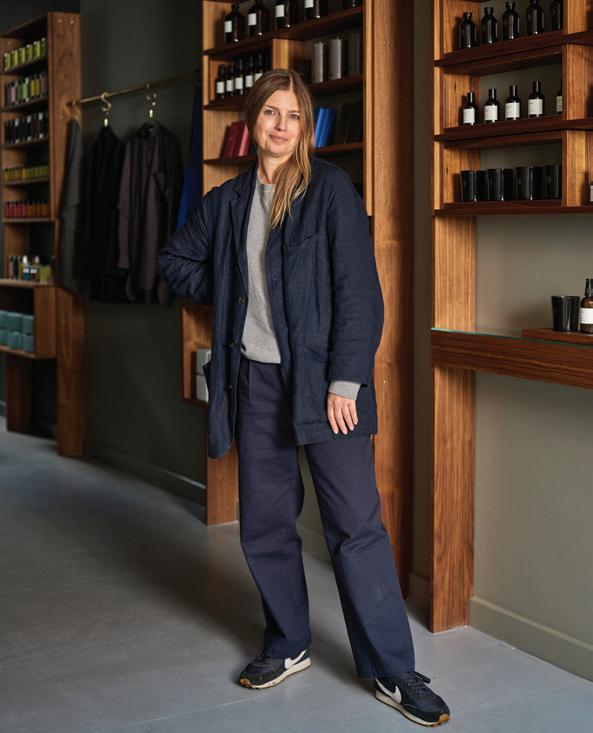
11 minute read
SCENTS OF PLACE
The Journal pays a visit to Perfumer H, home to the talents of Lyn Harris, one of the country’s most respected perfumers and a passionate advocate for the fragrances of nature
Words: Emily Jupp Images: Orlando Gili
Lynn Harris of Perfumer H
“I love sitting across from you and thinking, gosh, you would so suit Rain Cloud,” says Lyn Harris, giving me a discerning but friendly look. “Or Suede.”
Lyn, the founder of Perfumer H, is a British pioneer of natural fragrance and one of our country’s most distinctive perfume makers. She has become renowned and respected for her ability to replicate natural world experiences in scent.
Rain Cloud is a wet floral with ylang ylang, vetiver and angelica, which creates an interesting humidity. It smells like walking into a cloud, at the top of a mountain, overlooking a wildflower meadow, in a hot climate.
Suede is rather more, well, suede-like, with musky notes and white florals.
Lyn was exposed to great, natural smells from an early age and spent bucolic summers with her grandparents in the Scottish Highlands, where her interest in scent began. “My grandparents were self-sufficient, they had a smallholding and my grandmother would make jams and tisans, and she baked, so I would wake up to the smell of fresh bread each morning,” she says. “My grandfather was a carpenter and I loved to always be in his space. The garden was beautiful too – so the way we lived was all in tune with nature.”
Later, when she trained formally, she wanted to capture the atmosphere from her childhood. “I was obsessed with translating these smells I had in my memory,” she explains.
We meet in Perfumer H’s new Chiltern Street shop, which is decorated in dark mossy greys and greens, with walnut wood shelves which show off the candles and perfumes, held in exquisite hand-blown glass vessels made by Michael Ruh.
The brand has a second shop nearby on Crawford Street, which is where a creative lab and a refill station sit. You can take back any of the glass jars for a refill there – part of Perfumer H’s initiative to cut down on packaging and waste. Lyn’s desire is for the shops to provide accessible, unconventional fragrances that comprise natural scents, all in a sustainable way. “I don’t want people to be overwhelmed by the smell. I want it to be for them,” explains Lyn.
Her fascination with perfume began when she worked in her parent’s friends’ fragrance shop in Yorkshire, aged 15. “I loved how it transformed people. It was only for very wealthy people, buying Guerlain and Chanel – and I loved couture and that connection with fashion.”
School wasn’t particularly supportive and she didn’t go on to university, like many of her peers. “I wasn’t academic,” she says, but that shop had captured her imagination. “And then I read about this course in Paris and my parents said: ‘Just go.’”
Monique Schlienger was the lone female perfumer among a sea of men who taught the course in a little school by the Eiffel Tower. Lyn was there for two years, including six months in Schlienger’s laboratory, where the French doyenne encouraged her young English pupil. Schlienger recognised Lyn’s talent and would teach her one on one. “She could see I wasn’t scared of anything... and I could put things together.” She would talk about the smells and tastes in her garden and they would go out to eat and analyse the flavours. During her time at the school, Lyn learnt how to dissect smells and how to combine them.
Perfumery is both art and science. Understanding the way the chemicals and natural oils combine is science, which required Lyn to attend chemistry lessons in French (thankfully, she was assigned a translator). What you choose to combine is art. “I love naturals, but you realise the chemicals beautify everything and make everything so easy. The science blows your mind. You are given a framework – there are set techniques for making a rose floral, say, or a white peach, or a herbaceous leather note, or a sweet powdery undertone with musk – and you take aspects of these and make a smell. You slowly develop your technique.”
After her time with Schlienger, Lyn had developed a good understanding of the basic formulae at the heart of the olfactory craft. “You’ve got maybe 200 materials,” she says. “Rose has maybe 30 different variants, sandalwood has 10.”
Leaving Paris, she moved to Grasse, a French Riviera town famed for fragrance production since the 18th century. There, she studied at Robertet, “the Chanel of fragrance houses”, known for creating the best natural oils in the industry. “Being in Grasse was breathtaking,” she says. “Robertet is owned by this incredible
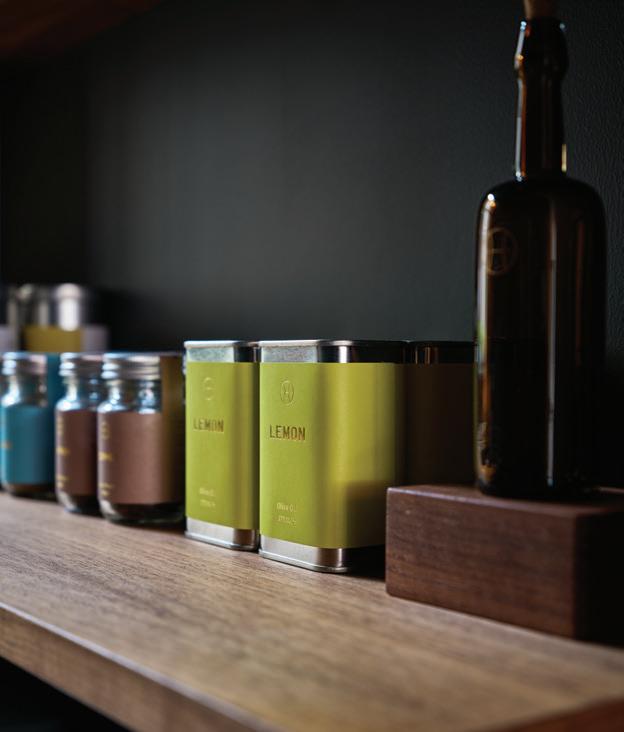
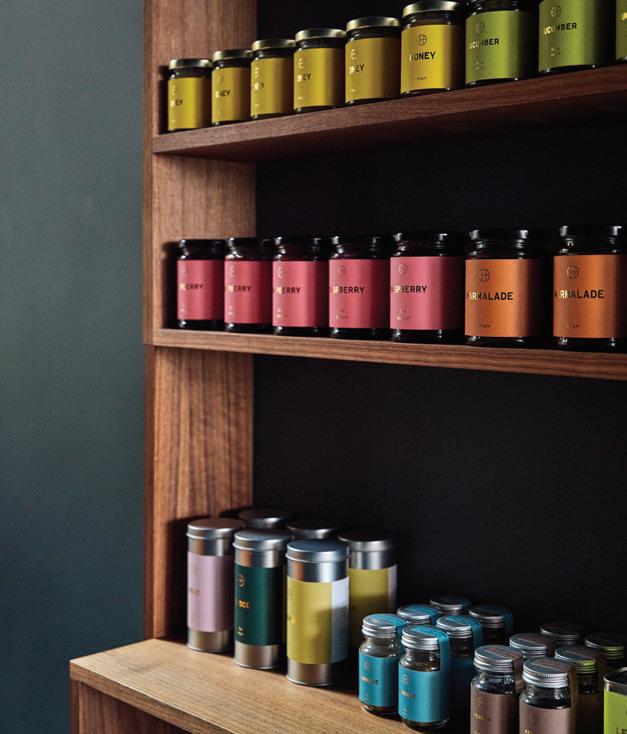
SCENTS OF THE SEASON CHRISTMAS PICKS FROM PERFUMER H
SAFFRON PERFUME The latest perfume from Perfumer H. Sensual, rich and warm. Saffron and sandalwood are enlivened by geranium leaf and frankincense on a base of cedar and papyrus with a hint of vanilla bourbon.
HONEY, SMOKE AND AMBER CANDLES The seasonal candles launched for winter are three quite complementary scents, so you can light two at different ends of the room for an interesting olfactory journey.
PRESERVES Preserves including marmalade, cucumber pickle and raspberry jam are all given a slight twist. The marmalade, perked up with a twist of bergamot and a pinch of lavender, has a cult following. “You shouldn’t really be using a powerfully scented washing powder. How can you wear perfume on top of that? You can even get scented toilet roll now. It’s horrific.”
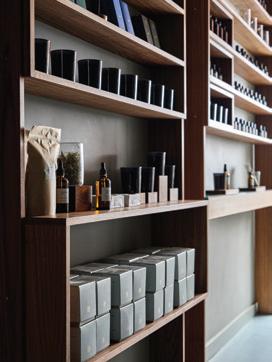
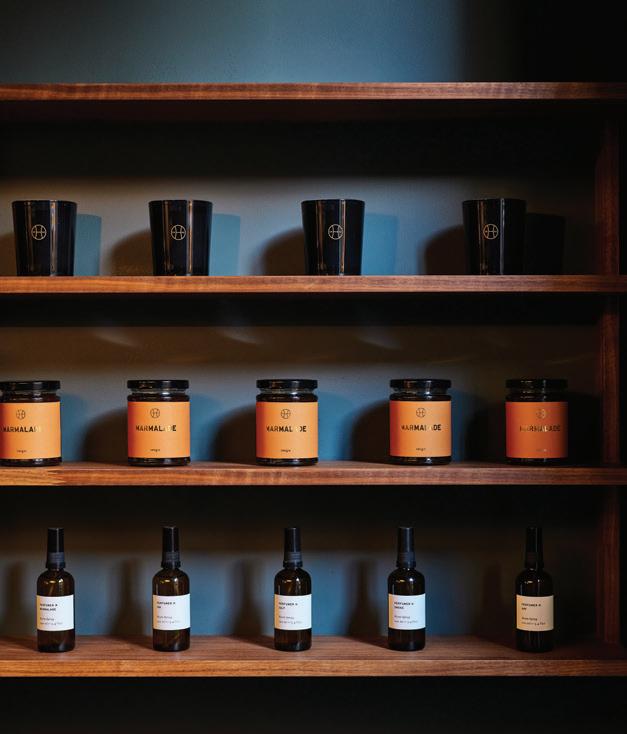
family and they said to me, ‘make Grasse your home’.” As a young British woman, she considered herself a bit of a novelty among all the male masters, but the experience was extremely valuable. She still has all her notebooks from that time. “I looked at them just yesterday. Oh my God, they’re bibles.”
She met her partner in life and work, Christophe, while in Grasse. “We both love the world of perfume, we are ruled by it, but in a beautiful way.” It was there, too, that she developed her own olfactory language. This is, she says, like a personal shorthand for describing different smells. “For example, sage for me is a leathery, very velvety herb note but very clean and green or has a feeling of white, while clary sage is much more dirty – you interpret it differently and then you learn how to work with them.”
Despite its historic status as the world’s fragrance capital, all was not well in Grasse, which was becoming increasingly depressed when Lyn first arrived. “Everyone had gone to New York and Paris,” she says. Around the world, fewer perfume makers were choosing to use costly natural oils in their scents. As the industry leaned more and more on synthetic chemicals, so most of the Grasse fragrance houses, which produced the natural oils, had been sold. The town’s beautiful fields of fragrant flowers, the source of the oils’ raw materials, had also gone. “When I opened my last shop, I was sent one of the very last tuberoses grown in Grasse and I was heartbroken.”
Lyn, however, refused to accept the new consensus. “Because perfume was becoming very synthetic, everyone smelled the same. I didn’t like that. I was told never to use naturals – to smell them for inspiration, but never use them. Naturals were considered too expensive. I rebelled and I said, well the industry was created around naturals, we must still use them.” Later, when she started work as an independent perfumer, this would become her hallmark.
After Grasse, Lyn worked with several different British brands, from Boots to The Body Shop to Liberty. She then worked at the French luxury goods corporation LVMH, home to some of the industry’s biggest perfume brands, and became their chief perfumer for 10 years. >
Then in 2000 she set up Miller Harris, which quickly became one of the most prestigious fragrance brands in the world. Ten years ago, she sold Miller Harris and in 2015 she launched Perfumer H in Marylebone – a smaller and more personal platform for her talents, releasing five fragrances, twice a year. She lives nearby with Christophe, and their son, Henri.
The Crawford Street shop and laboratory are part of Lyn’s plan to demystify scents. “Perfumery often hides behind this mask. These perfumers are lords, kings! It is true, you do have a magic, but why can’t I share some of my know-how with the world? That’s what happens in Crawford Street. I thought there’s so much mystery, why not show people?”
“This is me wiser, more grown up,” Lyn says of Perfumer H, “I took all that knowledge and created my new, stripped-back vision. This is about stripping back the industry, taking it back to its roots. When I was in Grasse, everyone was talking about the bottle or the advertising. No-one was interested in the juice, except that it had to sell as well as the last one. There was no creativity, it was very flat – and Grasse became a sad place.”
Over the past decade, though, a sea change in the industry has started to bring to the market more quality perfumes based on natural ingredients. In part, this is a reaction to the increasing number of people who are developing allergies from the chemical overload of artificially scented products. Research from the University of Melbourne has shown that as many as one in three people suffer health problems from exposure to synthetic fragrances: headaches, asthma, skin allergies, nausea or brain fog.
“The reason so many people are now allergic to fragrances is because these days everything is scented,” Lyn agrees. “This is one of the things we are trying to do with Perfumer H – to say that having a good quality fragrance is so important. You shouldn’t really be using a powerfully scented washing powder. How can you wear perfume on top of that? I want people to be aware, this isn’t how you should scent your clothes or home or your life. I mean, you can even get scented toilet roll now. It’s horrific. I remember my grandmother smelling of this beautiful fragrance of roses, but she washed her clothes with a plain soap bar – I want to go back to that.”
By fuelling the growing demand for real, high-quality perfumes, based on natural materials rather than synthetics, Lyn and her peers have caused a heartwarming change: they have brought the fields of flowers back to Grasse. “People like me revitalised it. This new era has come through for the town. Four years ago, I was sitting in the fields in Grasse, at Robertet. The tuberose has come back,” she says with a smile. “It’s like a reawakening.”
PERFUMER H 19 Chiltern Street, London, W1U 7PQ 106A Crawford Street, W1H 2HZ perfumerh.com
OLFACTORY FARMING
BEYOND PERFUMER H, MARYLEBONE IS A HOT SPOT FOR PERFUMES. HERE ARE OUR PICKS FOR CHRISTMAS
LIME DI SICILIA EAU DE PARFUM ORTIGIA A Classic Sicilian scent created for Ortigia by leading Italian perfumer Lorenzo Villoresi. Rich aromatic lime wood, flowers and oil from the scented lime tree: fresh and young yet complex. ortigiasicilia.com IMMORTELLE COLOGNE & COTTON One of the small range of exquisite colognes that give the brand its name: a cool and invigorating blend of mandarin, lemon and orange flower. cologneandcotton.com FLEUR D’ORANGER 27 LE LABO A natural orange blossom creation that took more than three years to compose. Fresh floral and lemony notes, rounded out by musk and the succulent, sunny touches of bergamot, petit grain and lemon. lelabofragrances.com RÊVE DE HANAMI RITUALS Named after the Hanami celebration that marks the flowering of cherry blossoms in Japan. A delicate bouquet of creamy, rosy florals, enhanced by bright notes of lychee, pear and bergamot. rituals.com NEW-YORK NICOLAÏ The signature fragrance of Patricia de Nicolaï, inspired by the city that never sleeps. A spicy, amber eau de toilette with black pepper, clove and patchouli on a citrus start. pnicolai.com GREY FLANNEL BY GEOFFREY BEENE GREY FLANNEL A sophisticated, masculine scent based on a blend of lemon, orange, violet, cinnamon and rose, accompanied by woody notes of oak and sandalwood. greyflannel.co.uk SUNSPEL OAK WOOD SUNSPEL Made for Sunspel by Lyn Harris. Top notes of bergamot and neroli, fused with English camomile and angelica seed, sit on a base of cedar wood, sandalwood and oak moss, sealed with amber and frankincense. sunspel.com MARRAKECH AESOP Inspired by the city of Marrakech, an eau de parfum built on clove, sandalwood and cardamom, celebrating the aromas of spices used in local dishes and the intense colours of the souks. aesop.com




